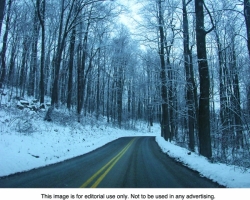Navigate Icy Roads Safely As Winter Hits Full Swing
Winter roads are rarely safe. Motorists who live in areas of heavy snowfall know full well the dangers of driving in the snow, while drivers who don't routinely drive on snowy roads might face slick and icy conditions as winter hits full swing.
Regardless of the obstacles a motorist faces in the winter, defensive driving is always the safest approach to take. Defensive driving involves anticipating potential dangers on the road, and those dangers include harsh weather conditions.
Though some regions never get any snow, most places where winters get cold do experience icy roads. To be safe on icy roads this winter, consider the following tips.
* Leave several car lengths between cars. Drivers who normally prefer one car length between their vehicle and the one in front of them should maintain at least three car lengths when the roads are icy. Ice is often difficult to see, much less predict, so it's safer to leave significant distances between vehicles in case an ice patch causes a car to spin out of control.
* Decrease speeds. Most people walk gingerly on ice, and the same should go for driving on ice. Driving at lower speeds is ideal in any harsh weather conditions, but especially valuable when the roads are icy and ice patches can appear suddenly and make it difficult to maintain control of a vehicle.
* Don't use overdrive or cruise control. Overdrive might help in a snowstorm, but should be avoided when the roads are icy. The same goes for cruise control, which should never be turned on when conditions are icy. Cruise control makes it easy for motorists' minds to wander, a dangerous consequence should an icy patch of road suddenly appear.
* When you have to brake, do so gently. Icy roads call for gently braking to avoid skidding. Drivers should be able to feel if their wheels are starting to lock up. If wheels begin to lock up, gently ease off the brake. Slamming on the brakes on an icy road will almost certainly send the vehicle into a tailspin, possibly pushing it into oncoming traffic or even off the road.
* Drive carefully on any bridges or overpasses. Warning signs accompany many bridges, informing motorists that the bridge freezes in icy conditions. But motorists shouldn't rely solely on signs to inform them of a potentially frozen bridge. The sign might not be visible in winter weather. To be safe, always proceed with caution when crossing a bridge in icy conditions.
* Be patient with snow plows and salt trucks. Snows plows and salt trucks might plod along the roads at a snail's pace, but drivers should never pass plows or salt trucks. The roads ahead of plows and trucks are likely in poor condition, and visibility from plows and trucks is often less than ideal, meaning the drivers might not see passing motorists, increasing the risk of a traffic accident.
* Don't be overconfident. Not all vehicles can adequately handle icy roadways. When the roads are especially icy, only drive if it's absolutely necessary. Should the local weatherperson forecast an ice storm in the coming days, visit the grocery store and stock up on food just in case the road conditions are too poor for driving. Don't rely on the local pizza man to deliver, as there's no guarantee his car will be able to handle the roads, either.
* Maintain a clean windshield. Ice patches are difficult enough to see as it is, but a dirty windshield only decreases the already limited visibility. Keep a bottle of windshield washer fluid at the ready and don't simply rely on the fluid already in the vehicle's windshield fluid tank. In especially icy conditions, that fluid might freeze or ice may block the fluid from leaving the tank.
* Turn your lights on. Turn your headlights on when driving in icy conditions, even if it's the middle of the day. Motorists will no doubt be paying close attention to the road, looking for ice patches or other potential pitfalls. But drivers may be apt to see another vehicle if its headlights are on and will likely drive accordingly.
When the roads are icy, motorists should only drive if it's absolutely necessary. If the situation calls for driving on an icy road, remember these defensive driving tactics. TF112424




